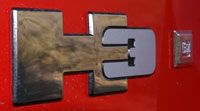KELSEY MAYS
Living Assistant
 Anela Holck/Assistant Photo Editor
Anela Holck/Assistant Photo Editor
Behind the wheel of a Hummer H3 SUV with the engine at full bore, I’m struggling to maintain 55 miles per hour up a slight grade on Pacific Coast Highway. In the passing lane comes, of all cars, a Toyota Prius. Oh, the irony.
I bet that driver had quite a chuckle. Never mind that the H3 is Hummer’s smallest and most fuel efficient vehicle — with a manual transmission, it’s rated at 20 miles per gallon on the highway, but to the person driving the 110-horsepower hybrid, muscling past a truck that weighs the equivalent of two Hyundai Accents must have brought satisfaction galore.
Suffice it to say that the H3 is not a fast vehicle, even in the realm of SUVs. New for 2006, this Hummer follows the full-size H2 introduced in mid-2002 and the king-size H1, which traces roots back to the U.S. military’s Humvee. At 17 inches shorter and seven inches narrower than the H2, it ranks as the smallest of the three. But lest you think it’s small in real-world terms, consider that its dimensions are comparable to Honda’s largest SUV, the seven-seat Pilot.
Built on GM’s midsize truck platform, the H3 has the same underpinnings as the Chevrolet Colorado and GMC Canyon midsize pickups, and it gets the same Vortec 3500 inline-five engine. Introduced with both pickups in 2004, the 3.5-liter engine makes 220 horsepower and 225 pounds-feet of torque — numbers that have since been overrun by high-displacement V-6s in Toyota and Nissan’s midsize trucks. Compounded by the H3’s extra weight (at 4,700 pounds, it’s 15 percent more than a four-wheel-drive Colorado Crew Cab), the engine feels overwhelmed at times.
An advanced transmission could have sorted things out a bit, but H3s only get low-tech four-speed automatic or five-speed manual options. My vehicle came with the former, which would not summon much power beyond a fourth-to-third downshift on high-speed uphill grades.
Automotive News reports that GM may pop a V-8 into the H3 in the next couple of years, so I won’t knock its power anymore.
I will devote a few words to the brakes, however. Although four-wheel discs with ABS are standard, the pedal feels very spongy. Kicking down hard produces adequate deceleration, although it takes quite a stomp to do so.
Handling is on par with non-sporty SUVs, which means average at best. The suspension allows plenty of body roll and isolates the cabin from most minor disturbances, though anything major — for example, a pothole or speed bump — induces a great deal of rocking. Steering feels evenly boosted and brings a respectable 37-foot turning radius.
The seating position is fairly high, with a step-in height of more than two feet in my test vehicle, which had optional off-road tires. A high beltline, thick roof pillars and short windows don’t offer great visibility, but thanks to the vehicle’s overall size, there is still a commanding view of the road out front. In back, sightlines are minimal because a tail-mounted spare tire obscures part of the small rear window.
The short windows are all part of the vehicle’s overall styling theme, which mimics Hummer’s larger H1 and H2. The H3 sports the same boxy frame and signature grille, with circular headlights peering through its chrome slats.
The ultra-tough design is polarizing, but it’s quite functional. Hummer claims an approach angle (a good indicator of exactly which bumps the H3 will climb) of 40 degrees with the off-road tires, which far exceeds most competitors. Four-wheel drive is standard, and a locking rear differential that keeps a rogue wheel from spinning in, say, a patch of mud, is optional. The only off-roading my test vehicle endured was a mountainous dirt road for a photo session, but on paper, the H3 looks very capable.
The interior does a fine job protecting occupants from whatever harsh elements might be outside. Dashboard controls feel high-quality, and the instrument panel features easily readable gauges with silver surrounds. Optional beige leather seats in the test car had contrasting piping and looked and felt very upscale. Both rows of seats — there is no third row — offer ample room.
Some controls are maddeningly complex, though. Case in point: Cruise control requires drivers to flip a switch on the left steering-wheel stalk and then push the switch inward to accelerate. To decelerate, a seemingly unrelated button on the outboard side of the stalk must be pushed. A slip of the hand could activate any of eight settings for the windshield wipers, flash the high-beam headlights or activate a turn signal, as all four systems are integrated into the same appendage.
Another cause for concern is the lack of certain standard features. H3s begin at $29,500, and my loaded tester rang up to nearly 10 grand more. But even at that price, it lacked front-side or side-curtain airbags (the latter is an option).
These reasons coupled with the overburdened engine prevent a full recommendation of the H3. Certain aspects — the off-road prowess, handsome interior and abundant storage space — offer notable selling points, but as an overall package, there are better choices for a $35,000 SUV.
None of them come close to the visual presence of an H3, though. So if you have rivers to ford and trails to blaze (OK, puddles to splash and a muddy driveway to climb) perhaps you can rationalize this purchase. After all, nothing starts conversation quite like the phrase, “Hey, I just bought a Hummer.”
11-10-2005

